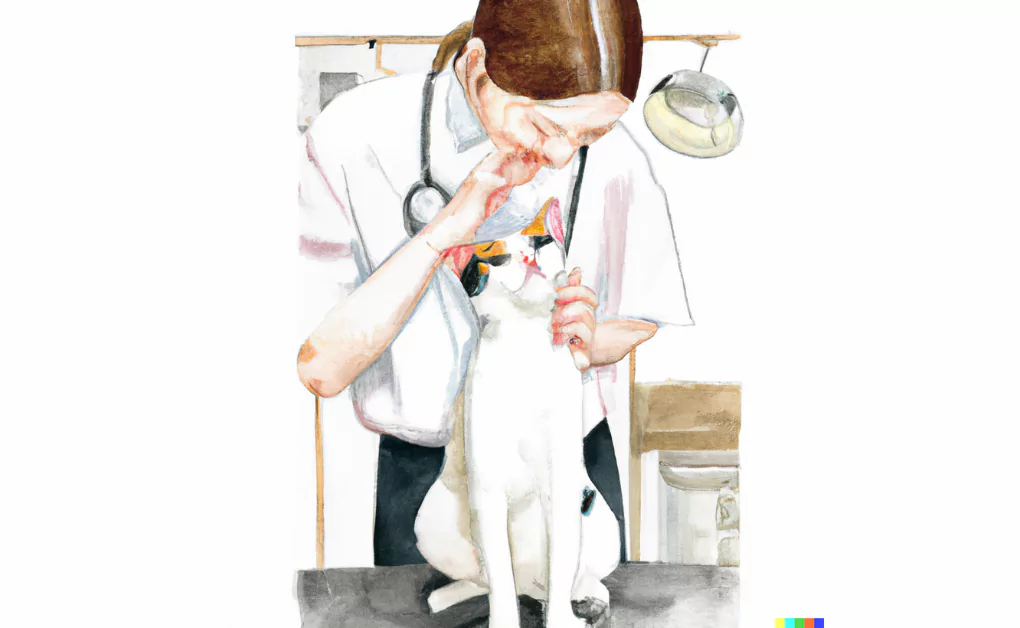What are Ear Mites in Cats?
What is it?
How is it Treated?
Breed Predispositions
Ear mites can affect any cat breed ad is typically more common in outdoor or stray cats due to their increased exposure to other cats and animals that may be carriers of the mites.
Introduction
One evening, while cuddling with her affectionate Siamese cat, Nala, Jenny noticed her feline friend excessively scratching her ears and shaking her head. Upon closer inspection, Jenny spotted tiny, dark specks in Nala’s ears, prompting her to visit the veterinarian for a thorough examination. The vet quickly identified the problem: Nala had ear mites, a common issue affecting cats of all breeds.
Ear mites, specifically Otodectes cynotis, are microscopic parasites that target the ear canals of both dogs and cats. They are a common cause of ear infections, particularly in cats. These mites are highly contagious, swiftly passing from one animal to another through direct contact. They are so tiny that they can barely be seen without magnification and have an average lifespan of three weeks.
Timely diagnosis and treatment are crucial to eradicate ear mites and relieve the symptoms they cause. While ear mites are typically harmless and don’t pose a severe health threat, intense infestations can lead to secondary bacterial infections and potential damage to the ear.
Ear mites, including free-ranging dogs and cats, are common among young and outdoor animals. However, pets with limited outdoor exposure aren’t immune, with about 25 percent of pet cats and 6 percent of pet dogs being affected. Therefore, regular check-ups and early detection are essential to prevent the formation of mites in the ear and ensure your pet’s comfort.
Causes of Ear Mites in Cats
Ear mites in cats, specifically Otodectes cynotis mites, are usually caused by direct contact with another animal with these mites. Here are some factors that can lead to an ear mites infestation in cats:
Direct Contact with Infected Animals
Ear mites, specifically Otodectes cynotis mites, are extremely contagious among animals. If a cat interacts directly with another animal infested with these mites, it can easily transfer. This is especially common if a cat spends time boarding or in a shelter with other cats. Introducing a new pet to the household without proper vet check-ups and treatment for parasites like ear mites can also lead to infection.
Environmental Exposure
Even if a cat doesn’t directly interact with an infested animal, it can still contract ear mites from an environment that an infected animal has frequented. For instance, ear mites and their eggs can survive in carpets, rugs, blankets, and other soft furnishings. This is especially relevant in multi-pet households or places where pets are boarded together, such as kennels or veterinary clinics.
Poor Sanitation and Ear Wax Build-up
Cats living in unsanitary conditions or with excessive ear wax can be more susceptible to ear mite infections. Ear mites thrive in the dark, warm environment of a cat’s ear canal, particularly if wax builds up. Regular grooming, cleaning, and maintaining the cat’s ear health are essential for preventing mites and other feline diseases.

Immunosuppression
Cats with weakened immune systems may be more susceptible to ear mite infestations, which can lead to secondary infections. A weakened immune system can be due to age (very young kittens or older cats are at higher risk), existing illnesses (like feline immunodeficiency virus), malnutrition, or stress.
Lack of Preventive Care
Many modern cat parasite preventives offer protection against ear mites. If a cat owner isn’t applying such a treatment regularly, especially for outdoor cats, their pet may be at a higher risk of contracting ear mites. These treatments usually come in topical “spot-on” products but can also include certain collars or oral medications.
Even though any cat can get ear mites, regardless of how clean their environment is or how much care they receive, understanding and mitigating these risks can help significantly reduce the likelihood of an infestation. Regular veterinary check-ups are crucial for preventing issues such as ear mites and other common causes of feline ear disease.
Symptoms of Ear Mites in Felines
Ear mites, a common parasite affecting cats, were the second most prevalent parasitic presence, detected in 17.3 percent of cats across seven European countries – a frequency even higher than that of fleas. When a cat is infected with these mites, certain symptoms can suggest their presence:
- Ear Itching: One common sign of ear mites is itchy ears. Cats often display this by repeatedly scratching at their ears, using their paws or rubbing their heads against surfaces like furniture or the floor to relieve the itchiness.
- Frequent Head Shaking: Cats may frequently shake their heads, almost as if attempting to dislodge something uncomfortable from their ears, indicative of ear mites.
- Dark Discharge: A common symptom of ear mites is a crumbly, dark discharge from the ears that resembles coffee grounds. This discharge may be accompanied by a foul odor, adding to the discomfort and ear irritation of the cat.
- Ear Inflammation: Cats may show signs of inflammation in their ears, such as redness, swelling, or sensitivity upon touch, due to the severe irritation caused by the mites.
- Hair Loss: The intense scratching and discomfort can result in hair loss in the areas around the ears.
- Skin Sores: In severe cases or when secondary infections occur due to ear mites, sores or lesions may develop on the skin near the ears.
These symptoms can also accompany severe skin and ear infections if the mites are not treated promptly. It’s important to note that you might not always see the mites, but the symptoms are quite indicative. Moreover, ear mites are contagious and can easily be passed onto an infected animal, especially if your cat spends time in boarding facilities or near other animals.
If your cat is showing symptoms of ear mites, it’s crucial to have them examined by a veterinarian. They can confirm the diagnosis and provide the appropriate treatment to ease your cat’s discomfort and prevent further complications.
Diagnosing Ear Mites in Cats
When suspecting ear mites in cats, a professional evaluation is necessary. Veterinarians use various methods to determine whether ear mites are causing the ear problem or whether the symptoms point to a different issue. Below are the common diagnostic strategies implemented:
Physical Assessment
The vet will examine the cat’s ears visually during a physical assessment. They will be looking for symptoms of ear mite infestation, such as a dark discharge, redness, swelling, or other noticeable irregularities.
Collection and Examination of Ear Samples
By gently inserting a cotton swab into the cat’s ear canal, a vet can perform ear cytology to collect a sample of the ear discharge or debris. This sample, often of ear wax and skin, is subsequently examined under a microscope for ear mites, their eggs, or fecal matter.
Use of Diagnostic Staining
Sometimes, a vet may use an otoscope to look closer at the cat’s ear canal and eardrum. Additionally, they might apply a specialized staining solution to the ear canal, which, under magnification, can expose the unique structures of the mites.
Observation of Treatment Response
An infected cat’s positive response to particular treatments, like ear drops or certain medications designed for ear mites, can further confirm the diagnosis. If clinical signs improve and symptoms resolve following treatment, it indicates the presence of ear mites.
Remember, ear mites can easily spread to other household pets, so if you see symptoms, you must ask your vet for advice and get a prompt diagnosis. Ear mites are extremely contagious external parasite. Therefore, immediate consultation with a veterinarian is vital if your cat is showing symptoms. They will conduct necessary tests and examinations to ensure an accurate diagnosis and suggest suitable treatment options for your cat’s situation.
Treating Ear Mites in Cats
When addressing the issue of ear mites in cats, veterinarians use several strategies to eradicate the mites and alleviate the associated discomfort. Here are typical approaches used:
Ear Cleansing
The first step towards effective mite treatment usually involves thorough ear cleaning performed by a veterinarian. This process entails removing excessive debris and discharge, enhancing subsequent treatments’ effectiveness.
Medications
- Prescription Drugs: Veterinarians often prescribe topical ear medications such as ear drops or ointments containing parasiticides designed to target and exterminate the ear mites. These medications require consistent application as directed by the vet, typically over a specified duration.
- Systemic Drugs: In certain scenarios, oral medication might be necessary to treat ear mites and address potential secondary infections or inflammations that may have arisen.
Additional Interventions
Environmental Sanitation: It’s recommended to sanitize the cat’s living space, including cleaning bedding, toys, and any surfaces that might harbor mites, to prevent re-infestation. Treatment of Other Pets: If other pets are present in the household, they may require mite treatment, too, to prevent the spread of ear mites.
Post-Treatment Care
Following the initial treatment, the vet will also schedule follow-up visits to track the cat’s progress, monitor its treatment response, and offer additional treatments or adjustments.
It’s crucial to follow the veterinarian’s guidelines regarding the application of ear drops, frequency, and treatment duration to ensure that the mites have been eliminated effectively. While emergency care might not be needed for ear mites, it’s important to understand that at-home treatments do not kill all ear mites and could delay necessary professional treatment.
Therefore, it’s only recommended to rely on home remedies for ear mites if explicitly recommended by your vet. Regular veterinary examinations and ongoing preventative measures are essential for maintaining ear health and preventing future infestations. Moreover, the vet may prescribe medication for other household pets to prevent other mites from spreading.
Preventing Ear Mites in Cats
Pet owners can take several measures to help prevent ear mites in their cats. By following these preventive strategies, you can reduce the risk of ear mite infestations:

- Regular Vet Check-ups: Regular check-ups by a veterinarian can help catch and treat any potential infestations early. Your vet will examine your cat’s ears as part of their standard physical exam and can spot signs of mites or other ear problems before they cause serious discomfort for your cat.
- Proper Hygiene and Care: Regular grooming and cleaning your cat’s ears can help keep them from mites. However, be careful not to clean too frequently or too deep, as this can lead to irritation. Always ask your vet for advice on proper ear-cleaning techniques.
- Parasite Prevention: A monthly, vet-recommended parasite preventative that covers ear mites can be a good option. Many of these are topical treatments you apply to the skin on the back of your cat’s neck. There are also certain collars and oral medications that can prevent ear mites.
- Isolate Infected Animals: If one of your pets is infested with ear mites, isolate them from other pets until they have been treated. This will help prevent the mites from spreading.
- Clean Environment: Clean bedding and grooming tools regularly. Mites can survive for a short time in the environment, so a thorough cleaning can help remove any mites or eggs that may have been shed.
- Check New Pets: If you’re introducing a new pet into your home, have them examined by a vet before they contact your existing pets. The vet can treat them if they have mites, preventing them from spreading to your other pets.
- Monitor Outdoor Cats: If your cat goes outdoors or has contact with other animals, be aware they have a higher risk of getting ear mites. Regularly check their ears for signs of mites, such as excessive scratching or dark debris in the ears.
By following these guidelines, pet owners can significantly reduce the risk of ear mite infestations in their cats. Always consult with your vet if you suspect your cat may have ear mites or for advice on preventive treatments.
Frequently Asked Questions
Disclaimer: The information provided on this veterinary website is intended for general educational purposes only and should not be considered as a substitute for professional veterinary advice, diagnosis, or treatment. Always consult a licensed veterinarian for any concerns or questions regarding the health and well-being of your pet. This website does not claim to cover every possible situation or provide exhaustive knowledge on the subjects presented. The owners and contributors of this website are not responsible for any harm or loss that may result from the use or misuse of the information provided herein.







